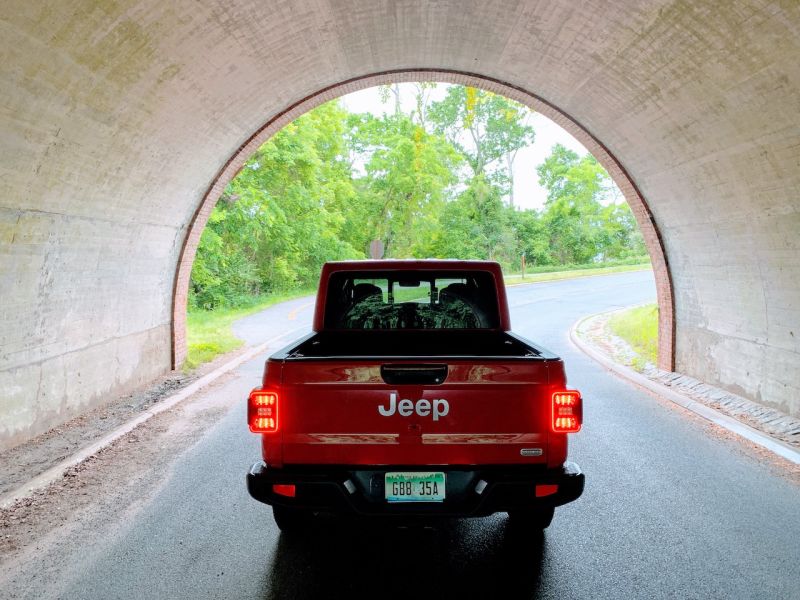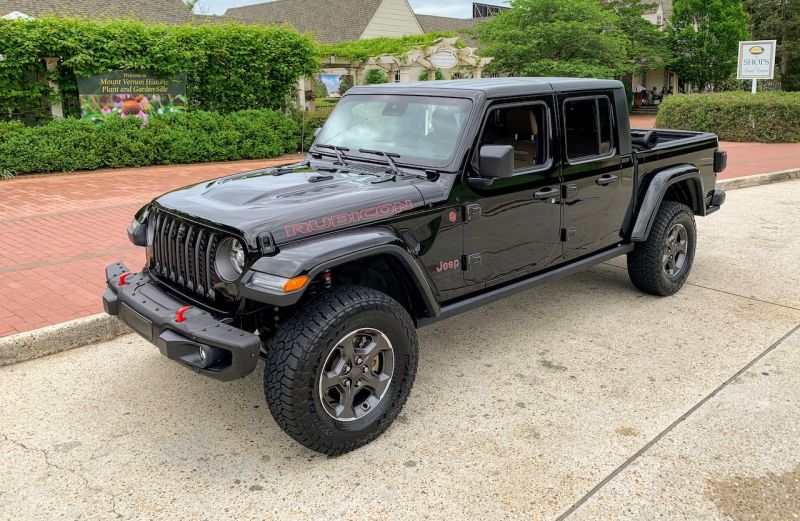
Until very recently, the Comanche was Jeep’s most recent pickup truck – and it ceased production in 1992. With modern half-ton trucks too big for most buyers’ needs, the midsize truck market has taken off, and Jeep wanted a piece of the pie. Their hotly-anticipated entrant is the 2020 Jeep Gladiator.
Jeep wanted me to drive a Gladiator so badly that they invited me and several other members of the Washington, DC press to spend the day driving them. They also fed us lunch and gave away some Jeep swag.
The Comanche was, more or less, an XJ Cherokee hacked apart behind the front doors, with a boxed rear frame and bed stuck where the rest of a normal Cherokee used to be. It was neat, and marginally useful, but with Gladiator, Jeep set out to make a “real truck” that was also as capable off-road as any other vehicle in their lineup.
Gladiator engineers took the JL Wrangler and stretched the wheelbase to 137″. Overall length is increased by 31″. Compared to a four-door Wrangler, the Gladiator is a big boy. Jeep made a big deal about the extra wheelbase contributing to stability while towing or hauling, and if properly equipped, the 2020 Jeep Gladiator can tow an alleged 7,650 lbs.
Given the towing needs of the motorsport community, I drove several Gladiators with that “7,650 lbs” number in mind. I drove a Gladiator Overland and two Gladiator Rubicon models – one with the 8-speed automatic and one with the 6-speed manual.
My first impression of the Gladiator was “wow, this is small.” I had just climbed (fallen?) out of a Ram 3500 dually, so nearly anything would feel small by comparison. Regardless, the Wrangler and Gladiator are somewhat narrow vehicles compared to the half-ton “big truck” siblings that many of us are used to. In reality, it’s a pretty good size and similar to other midsizers like the Tacoma, Colorado, and Ranger.
The first Gladiator I took out was an Overland trim, equipped with the 8-speed automatic. Every Gladiator (for now) is sold with the corporate 3.6L Pentastar V6 engine, which makes about 280 horsepower and 260 ft-lb of torque. It pairs well to the 8-speed, and the truck felt punchy, both off the line and at speed. The Pentastar does need to be wound out to make that power – low-end grunt is not in abundance as in forced-induction engines.
Following the Overland, I drove the Rubicon, in both automatic and manual form. Notable changes to the Overland include Falken all-terrain tires (compared to Bridgestone Dueler H/L on other trims), 4.10 gearing (3.73 is standard), and custom-for-Jeep Fox shocks. The Overland rides a bit softer and “squishier” as a result.
Acceleration in the automatic Rubicon and Overland was adequate, but the manual-transmission Rubicon felt absolutely glacial by comparison. While the throws were short, multi-gear downshifts were required to pass, and sixth gear seemed reserved for cruising at 70+ mph (which, given our drive route, was not possible). It didn’t feel as slow as, say, an old 4.0L Wrangler, but it was close. I suspect the gearing in the manual transmission works against the vehicle as a whole. The 8-speed auto can have a short first gear to help off the line, and more gears overall help spread the workload. On the plus side, the pedals in the manual Gladiator are perfectly spaced for some heel-toe downshifts.
Jeep will be bringing the 3.0L EcoDiesel V6 to Gladiator next year, and it will be far torquier, at 440 ft-lb. However, maximum towing capacity is achieved with a very specific combination of options (Sport S trim, Pentastar, automatic, 4.10 gearing). Jeep was unable to share the maximum tongue weight that Gladiator can support. An integrated trailer brake controller will be available later this year. For now, you’ll have to rely on an aftermarket solution.
Aside from the sluggish Pentastar/manual drivetrain combination, I didn’t find much to fault with the 2020 Gladiator. The front seats do not allow for tilt adjustment in the front, making thigh support for the longer-legged pretty poor. I’m not sure how I’d fare on a longer trip in a Gladiator.
That said, the 2020 Gladiator is a bigger Wrangler, which you either love or hate. I think Wranglers are fun, and the idea of having a convertible pickup truck that can tow with the doors removed sounds like a great time. But, with that fun persona comes the lack of any real “luxuries” – yes, you can get a heated steering wheel and leather seats in Gladiator, but at its core, it’s still Wranglerish and you can’t expect it to be a quiet, calm cruiser like a loaded half-ton truck may feel.
I asked about bringing my enclosed trailer to test behind the Gladiator, but time constraints did not allow that test to take place. FCA does not loan press vehicles to smaller outlets, so I will have to pester a local dealer to see how stable a Gladiator feels with an enclosed hitched up. The truck will absolutely tow a car on an open trailer, and the wheelbase indicates it could handle the aerodynamic demands of a smaller enclosed (it’s only a few inches shy of a Ram 1500), if you’re okay pushing the Pentastar harder than a torquey V8.
For those who need a truck to perform homeowner duties, carry a dirt bike, or look cool parking at the Cheesecake Factory, the Gladiator has you covered in spades. When it comes to that “best in class towing” claim, the jury is still out.

See more at Out Motorsports, a site created to not only share the pursuits of LGBT motorsports competitors, but to encourage others to get behind the wheel and participate as their full selves.